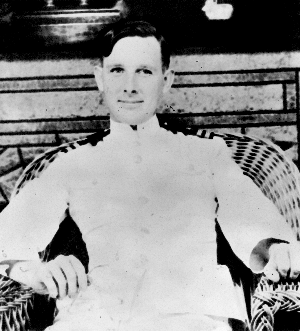 Joe Rochefort’s War
Joe Rochefort’s War
The Odyssey of the Codebreaker Who Outwitted Yamamoto at Midway
By Elliot Carlson, 616 pp.
Naval Institute Press, 2011. $36.95.
During early 1942, a cell of colorful, oddball radio intelligence specialists in a dingy basement at Pearl Harbor labors to break the Imperial Japanese Navy’s coded messages. Led by Commander Joseph Rochefort, often attired in a smoking jacket and slippers, they succeed brilliantly. That arms Admiral Chester W. Nimitz with the priceless knowledge he needs to mastermind the pivotal victory at the Battle of Midway. Then, as in a classic Greek tragedy, Rochefort’s highly placed enemies not only deny him his just recognition but also contrive his ignominious exile to the command of a floating dry dock.
This is an oft-told tale—one, as Elliot Carlson’s new biography demonstrates, that has been woefully incomplete, or inaccurate, or both. Joe Rochefort’s War is a brilliant triumph, reflecting both the author’s astonishingly comprehensive research and his sympathetic but clear-eyed analysis. Unlike too many biographers, who either love or hate their subjects, Carlson clearly admires Rochefort’s achievements, but is completely fair and candid about his flaws.
A high school dropout, Rochefort gained his commission via an officer’s training program in World War I. From then on, his unusual career path would prove crucial, equipping him for his critical role in 1942. He did early work in code breaking, a field in which hyper-secrecy seriously imperiled career advancement. But with a keen eye on promotion and an emerging bent toward self-defeating stubbornness, Rochefort actively avoided any billet connected to communications intelligence from 1928 to 1941. Instead, he studied Japanese from 1928 to 1932, and then frequently served as a staff officer for senior admirals—including Joseph Reeves, who commanded the battle fleet from 1933–36. Carlson skillfully traces how these duties equipped Rochefort with profound insight into the highest levels of fleet operations and strategy—obviously vital for his work on Midway. But both Rochefort’s role as the messenger for the impatient, tactless Reeves and his own penchant for indiscreet derogatory comments about peers and superiors ultimately manufactured enemies with long memories. They would eventually bring him down.
Once Rochefort reaches Pearl Harbor in June 1941, Carlson succeeds where no one else has: he explains in convincing detail what made this often-abrasive personality so indispensable and successful. Rochefort was by no means even remotely as brilliant a code breaker as, say, Thomas Dyer, one of his staff officers. Rochefort was a highly capable linguist and able intelligence officer, but so were many others. The edge that Rochefort’s background gave him, Carlson argues, was his unique and irreplaceable ability to take fragmentary recoveries of the contents from a small portion of Japanese operational-message traffic and somehow connect these scattered shards into a remarkably accurate Big Picture of Japanese intentions and plans. This is just what he did for Midway. The complex story of how he ran the collegial and free-wheeling operation that produced the info-shards, and how he managed, against the odds, to link them, is as enthralling as any mystery. Carlson, in addition to his other virtues, is a fine storyteller.
Carlson is equally adept at handling the rest of Rochefort’s saga, as Midway’s hero slides almost inexorably from triumph into exile. For starters, Carlson unveils exactly who brought Rochefort down, and why. (It was not, as many believe, Admiral Ernest King.) He also takes pains to point out where Rochefort’s memory erred about key events, and how that distorted prior accounts. But there is much more. Anyone interested in the Battle of Midway should want to know more about the obscured genius at its center. This superb biography delivers Rochefort in full—the achievements and the man




